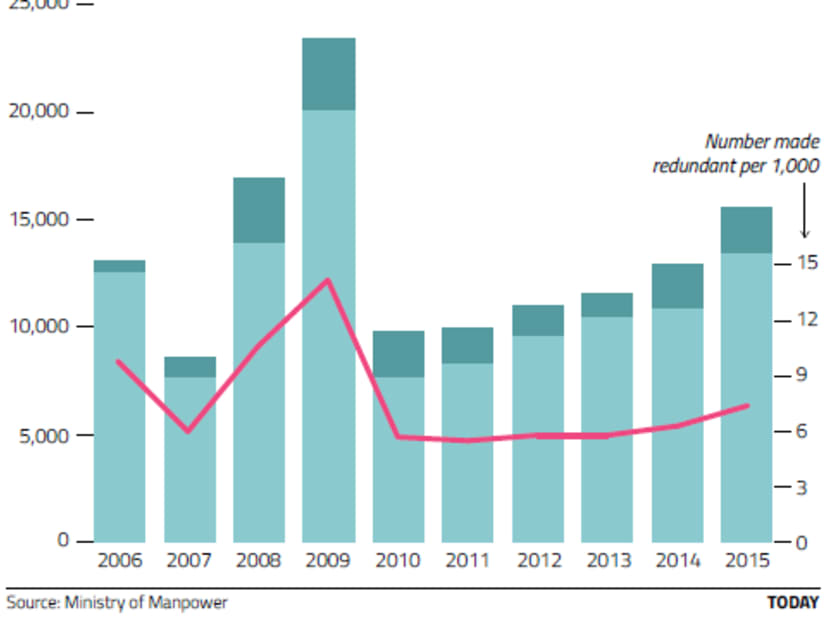Lay-offs last year highest since 2009 global crisis
SINGAPORE — The number of workers laid off last year spiked 20.5 per cent compared with 2014, reaching 15,580 — the highest number since the global financial crisis seven years ago, the latest Ministry of Manpower labour market report showed on Tuesday (March 15).
SINGAPORE — The number of workers laid off last year spiked 20.5 per cent compared with 2014, reaching 15,580 — the highest number since the global financial crisis seven years ago, the latest Ministry of Manpower labour market report showed on Tuesday (March 15).
In 2009, the number of redundancies reached more than 23,000. The majority of last year’s lay-offs were in the services sector (55 per cent), where the financial services, wholesale trade and professional services were worst hit. Correspondingly, professionals, managers, executives and technicians (PMETs) made up 71 per cent of those laid off last year, up from 66 per cent in 2014.
The financial services sector — which had been hit by news of job cuts announced by global banks, affecting employees here — shed 1,710 jobs last year, compared to 1,280 in 2014. Over the same period, the number of workers laid off in wholesale trade climbed from 1,490 to 2,150, while job losses for those in professional services — including doctors, lawyers and accountants — rose from 1,520 to 2,290.
Workers who were laid off also found it more difficult to get a new job last year: Based on Central Provident Fund records, half of the residents made redundant in the third quarter of last year managed to secure employment by December, down from 55 per cent in the previous quarter, and 59 per cent in the same period in 2014.
MOM said it expects redundancies to continue to rise in sectors facing weak external demand and those that are undergoing restructuring. Domestic-oriented services sector will continue to need workers, the ministry said. “MOM is closely monitoring the current economic and labour market situation, and is strengthening employment support to help displaced locals re-enter employment,” it added.

Economists told TODAY that the slower global economic growth and the downturns in manufacturing as well as the oil and gas sectors have had a spillover effect into the services sector.
DBS Bank senior economist Irvin Seah said the slump in oil prices not only affect oil rig builders but the entire supply chain including smaller companies that support the oil and gas sector. The financial services sector would continue to see more job losses compared to other segments as it is going through some consolidation, Mr Seah said. As far as the labour market is concerned, the worst is yet to come as the global economic outlook deteriorates, he cautioned.
CIMB Private Banking economist Song Seng Wun said that while lay-offs may not necessarily increase over the year with some sectors still hiring, the pace of hiring may slow and this could push the unemployment rate up. “I would expect job seekers to take even longer to find a new job in the year head. Businesses may not be laying off more workers but they may not be that in a hurry to hire,” Mr Song said.
Unemployment rate for residents was 2.8 per cent last year, inching up from 2.7 per cent in 2014, while that for citizens remained unchanged at 2.9 per cent.
Mr Seah noted that the foreigners has borne the brunt of the job losses so far. “Companies are unwilling to let go of local workers because of the low foreign worker dependency ratio ceiling,” he said.
On the high proportion of PMETs laid off last year, Members of Parliament (MPs) from the labour movement attributed it to the fact that this group of workers comprise a higher percentage of the total workforce. Still, NTUC assistant secretary-general Patrick Tay, who is also an MP for West Coast GRC, said he was particularly concerned about PMETs above 40 years old, who would have a harder time finding a new job if they are retrenched.
Mr Tay, who co-chairs the Financial Sector Tripartite Committee which helps professionals seeking to find new jobs in the sector, suggested adopting a sectoral approach to provide more targeted and focused help in sectors where affected by high job losses.
Last month, the Association of Banks in Singapore announced that it has initiated a jobs portal that allows its members to refer their staff for suitable positions in other banks.
NTUC director of youth development Desmond Choo, who is an MP for Tampines GRC, said more efforts are needed to help PMETs. “We need to be able to re-skill, re-tool them (to join) other growing sectors … like healthcare and ICT (information communication technology),” said Mr Choo. More could also be done to provide “hardship support” for the families of retrenched PMETs while they look for a job, he added.
Advanced data released by MOM in January showed that Singapore saw its worst year-on-year employment growth since 2003 last year.
Confirming the labour market’s sluggish performance, the latest MOM report said that excluding foreign domestic workers, total employment grew by 23,300 – or 0.7 per cent – last year, compared to increases of 122,100 (3.7 per cent) and 131,300 (4.2 per cent) in 2014 and 2013, respectively.
The growth in local employment was flat: Only 700 of the jobs added were filled last year by Singaporeans and Permanent Residents, compared to 96,000 and 82,900 in 2014 and 2013 respectively.







